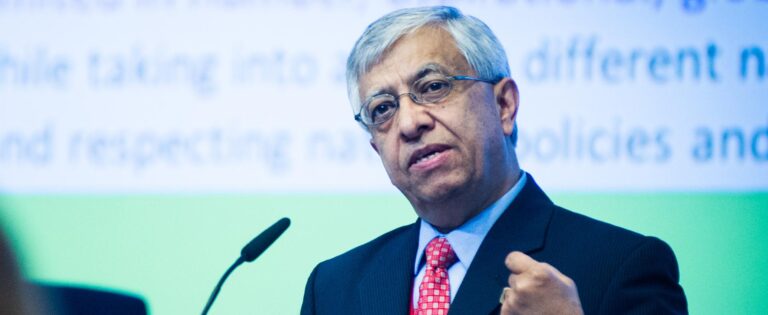Meteorologists were able to predict the Haiyan typhoon several days before it hit the Philippines on 7 November 2013, killing thousands. However, governments need decades of warning ahead of periods of extreme weather to enable them to build sea defences and protect low-lying areas.‘The decadal predictability experiments are just at their infancy,’ said Professor Asrar during an interview on 4 November on the sidelines ofThe International Conference on Regional Climate-CORDEX2013. The event, jointly organised by the WCRP, the Intergovernmental Panel on Climate Change (IPCC) and the European Commission, brought together scientists from 59 different countries to discuss climate forecasting.Scientists are under pressure from governments to harness longer-term forecasts as officials try to assess the risks of climate change to investments in local infrastructure such as roads, dams, electrical grids, ports and harbours.One of the things that is needed to develop climate forecasts that can make predictions 10 years or more in advance is for developing countries to build up their understanding of their local climates, said Prof. Asrar, who is now the director of the Joint Global Change Research Institute at the University of Maryland.However, there is a research gap between developing regions such as Africa and Southeast Asia in particular which needs to be filled.The WCRP is working to help fill this gap. It was founded in 1980 to help scientists foresee changes to the earth’s climate by getting the global scientific community to share their findings. This is something it has been doing in Africa by developing networks to flesh out climate science, Prof. Asrar said.The body recently convinced 12 global centres of excellence from around the world to focus on developing temperature and precipitation simulations for Africa. However, there is still much work to do. ‘This task of community building takes time, it takes energy,’ Prof. Asrar said.Never complex enoughOne of the main problems with making longer-term forecasts is that nature is very difficult to imitate in a mathematical equation, according to Prof. Asrar. ‘We can never make these models complex enough to represent nature but we have made tremendous progress by making these models as close to reality as possible,’ he said.Climate modelling is still much more accurate than it was thirty years ago, he said, because scientists are now factoring in the role of oceans, polar regions, the level of carbon in the system, and the amount of the sun’s energy absorbed by the earth, a process called radiative forcing.“‘We can never make these models complex enough to represent nature but we have made tremendous progress by making these models as close to reality as possible.’Professor Ghassem Asrar, the former director of the World Climate Research ProgrammeWhile global air surface temperatures have not risen as much as predicted, radiative forcing has increased, meaning more energy is being absorbed by the earth rather than reflected back into space. That has caused a build-up of heat that is landing in the earth’s oceans, the IPCC said in June 2013 in itslatest reporton climate change.Understanding the effect of radiative forcing on the oceans is critical to making longer-term forecasts. The WCRP is increasing its support for ocean observation by organising meetings, workshops and conferences to coordinate and facilitate research. ‘We believe that the signal for climate prediction is not only in the atmosphere, it’s also in the ocean,’ Prof. Asrar said.The contibution of research funded by the EU has been ‘instrumental’ in the progess made so far on developing climate models, he said. ‘The international climate research community anticipates this area of research to be a major priority of Horizon 2020 in Europe, and other research funding opportunities worldwide.’However, he believes governments around the world need to treat the environment as urgently as they may treat policies to boost economic growth. ‘Put the environment at the base of social and economic (development) and integrate that knowledge into every socio-economic discussion and decision.’He is optimistic about a new reform agenda as the UN comes to draft the next post-2015 phase of its Millennium Development Goals which have so far focussed on eradicating poverty and debt in the world’s least developed countries.‘Why not integrate environmental goals into those because, ultimately, you cannot have a thriving economy if the environment is not preserved.’
This article was originally published in Horizon, the EU Research and Innovation magazine.
Add to favorites:
Share:
Listing Description
Video
Documents
No documents available.
Ask KETMarket to make a contact
Connect with the Listing Owner!
💬 Please log in now to askKETMarket to make a contact. Not a member yet? Sign up for free and start connecting today!
Video
Related Funding and Finance Opportunities
Unlock Exclusive Funding Opportunities!
🔑 Get instant access to tailored funding opportunities that perfectly match your needs. This powerful feature is exclusively available to our premium members—helping you save time, stay ahead of the competition, and secure the right funding faster.
Upgrade to Premium now and never miss an important opportunity again! Already a premium member? Log in here to explore your matches.
Related Innovation Offers
Discover Tailored Innovation Offers!
🚀 Gain access to technology solutions that match your specific needs and interests—carefully selected to support your innovation goals. These offers are exclusively available to our premium members, helping you identify relevant technologies faster and start the right conversations with potential partners.
Upgrade to Premium now and explore your personalized technology matches today! Already a premium member? Log in here to view your tailored offers.
Related Knowledgeable Resources
Discover More with Premium: Related Knowledge Resources
🔒 You’re missing out on expert-curated knowledge specifically matched to this topic. As a Premium member, you gain exclusive access to in-depth articles, guides, and insights that help you make smarter decisions, faster.
Whether you’re preparing a funding proposal, researching a new market, or just need reliable information—our Premium knowledge matches save you hours of research and point you directly to what matters.
Upgrade to Premium now and instantly unlock relevant knowledge tailored to your needs! Already a member? Log in here to view your personalized content.

